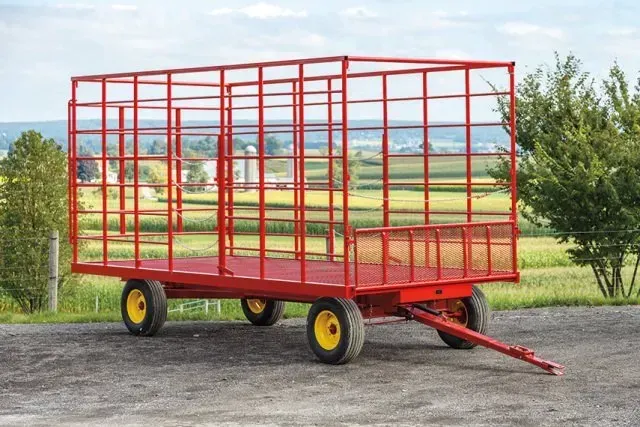
How to Safely Transport Large Equipment with a Hay Wagon
You’ve got a big load—a farm implement, a stack of large crates, or bulky tools—that needs moving across your property. You think: can I use my hay wagon for this? The idea is appealing, but transporting large equipment on a hay wagon introduces risks: shifting loads, overloading, or improper securing can damage the wagon or create safety hazards.
In this guide, you’ll learn:
The key principles of safely hauling large equipment using a hay wagon
What modifications or accessories help secure loads
A step-by-step checklist for safe transport
Answers to common questions and pitfalls
By the end, you’ll know how to turn your wagon into a reliable hauling platform—without compromising safety or durability.
What “Safely Transporting Equipment on a Hay Wagon” Means
Before diving into steps, let’s clarify the scope:
We’re talking about loads heavier or bulkier than typical hay loads—implements, machinery parts, crates, or farm tools.
The wagon might not have been originally built for this, so attention to load dynamics, anchoring, and structural limits becomes critical.
Safety, stability, and damage prevention for both load and wagon are the priorities.
Key principles to keep in mind:
Center of gravity: Keep loads low and centered to minimize tipping or shifting.
Secure anchoring: Use reliable tie-downs, chains, straps, or fixtures to prevent movement.
Overload protection: Never exceed the load rating of the wagon’s axles, tires, or frame.
Proper support & balance: Balance the weight front-to-back and side-to-side.
Safe transit speed & route planning: Choose paths and speeds that minimize jolts or sudden stops.
Step-by-Step Guide to Safe Transport
Here’s a systematic process you can follow when planning to move large equipment on a hay wagon:
Step 1: Assess the Load & Wagon Capacity
Determine the weight and dimensions of the equipment (height, width, length).
Check your wagon’s rated load capacity (frame, axles, tires).
Leave margin—do not run it at maximum capacity.
Consider how the equipment’s weight is distributed (heavy on one side?).
Step 2: Prepare the Wagon Bed
Clear the wagon deck of debris or leftover load material.
Inspect floorboards or deck surface for weak spots, cracks, or damage.
Reinforce the deck if needed (steel plates, cross beams).
Install anchor points: welded or bolted D-rings, stake pockets, rails, or brackets.
Step 3: Position the Equipment Correctly
Place the load as centrally as possible—both lengthwise and laterally.
Keep the load low: if part of the equipment can be disassembled or lowered, do so.
Avoid overhanging loads when possible. If unavoidable, ensure overhang is supported or flagged.
Step 4: Secure with Tie-Downs & Restraints
Use heavy-duty ratchet straps, chains, or load binders rated for the weight.
Anchor to the fixed points installed on the bed.
Use edge protectors, padding, or blankets to prevent damage where straps touch edges.
Cross the straps (X-pattern) when possible to resist shifting in multiple directions.
If equipment has wheels, apply wheel chocks or block movement.
Step 5: Check Clearance & Stability
Walk around the wagon and look from different angles to see if anything is leaning, loose, or likely to shift.
Test slow movements: gently pull forward, stop, reverse slightly, and observe whether the load shifts.
If any movement occurs, stop and resecure.
Step 6: Plan the Route & Drive Carefully
Choose the smoothest, flattest path. Avoid sharp turns, sudden stops, or rough surfaces if possible.
Drive slowly and cautiously—reduce speed around bumpy stretches, inclines, or declines.
Use gradual acceleration and braking to prevent load shift.
If crossing roads or driveways, ensure the height and width can clear overhangs or obstacles.
Step 7: Monitor During Transit
Stop periodically to inspect straps, check for shifting or loosening.
Tighten or adjust restraints if needed.
Watch for signs of fatigue, bent hardware, or stress in the frame.
Step 8: Unloading Safely
Park on level ground.
Release tie-downs in a controlled manner, one side at a time, while stabilizing the load.
Use assistance or lifting tools to lower heavy parts gently
Reverse the loading steps to ensure balance and safety.
Frequently Asked Questions
Q: Can any hay wagon handle heavy equipment?
A: Not all. Wagons built only for hay may lack sufficient frame strength, proper anchor points, or deck reinforcement. Always confirm load ratings and structural integrity first.Q: Should I use chains or straps?
A: Use a combination of both if possible. Straps (ratchet or webbing) secure light-to-moderate loads. Chains or load binders are better for very heavy or rigid loads. Always match rating to expected load.Q: What speed is safe when hauling heavy loads?
A: Generally, stay well under tractor or transport speed. Move slowly—especially over uneven ground or when turning. Reduce speed before dips, slopes, or bumps.Q: Do I need to modify the wagon for this use?
A: Yes—adding anchor points, reinforcing the deck, and possibly bolstering the frame are wise modifications. Building in features now saves risk later.Q: How much margin should I leave under capacity?
A: A good rule is to operate below 80 % of the rated capacity, so you have a buffer for bumps, shifting, or dynamic loads.
Conclusion
Transporting large equipment with a hay wagon is entirely feasible—but only when done with care, planning, and proper securing. By assessing your wagon’s capacity, reinforcing where needed, anchoring correctly, and moving cautiously, you can safely haul heavy loads across your farm without risking damage or accidents.
If you need help reinforcing your wagon, adding secure anchor systems, or choosing suitable ratchet-strap setups, Gap Hill Farm Wagons can assist with custom upgrades, parts, or consultation.